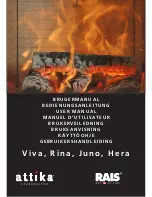
~
10 ~
The settings of both of these air controls very much depends on draught and local condi-
tions and after a few fires, you should have a good idea of the best settings for your
stove. The air controls should be fully opened when lighting the fire. Once the fire is es-
tablished, the controls may be adjusted as required. Reducing the air intake will cause the
stove to burn slower. This may cause some blackening of the stove glass, but this should
burn off once the stove is burning brightly again.
Refueling
Before refueling your stove, turn the air supply to high for a few moments until there is a
good fire in the stove. This will ensure there is no build-up of harmful gases in the stove
when the door is opened and will also get the new fuel burning quickly and not allow it to
kill the fire.
To reload the stove, open the door and feed the fuel in slowly using tongs or a small sho-
vel. Do not overfill the stove. It is always better to put in small loads often rather than big
fills less frequently. Close the door gently after stove is reloaded.
You should always wear protective gloves and use tongs when tending a hot stove.
Ash removal
Your stove is fitted with a shaker grate to remove the ash from the firebox. Use the oper-
ating tool to move the shaker knob forward and back. This will allow the ash to fall into
the ash pan under the fire bed. This can also be achieved by using a poker.
When ash has built up in the ash pan, it should be emptied. Failure to do this will cause
ash to build up around the grate and may cause your grate to warp or burn out. It is es-
pecially important when burning fuel with high ash content that you keep your grate clear
and your ash pan emptied regularly, so as not to damage your grate. Clear the grate with
the shaker bar or a poker regularly.
To remove the ash, open the stove door and use the operating tool provided to lift the
ash pan out of the stove. If possible, this should be done before lighting the stove when
the ash is cold. Even if the ash appears to be cold, it should be placed in a non-
combustible container as there may be hot ash in the center of the pile. You should al-
ways wear protective gloves when removing ash from the stove.



































